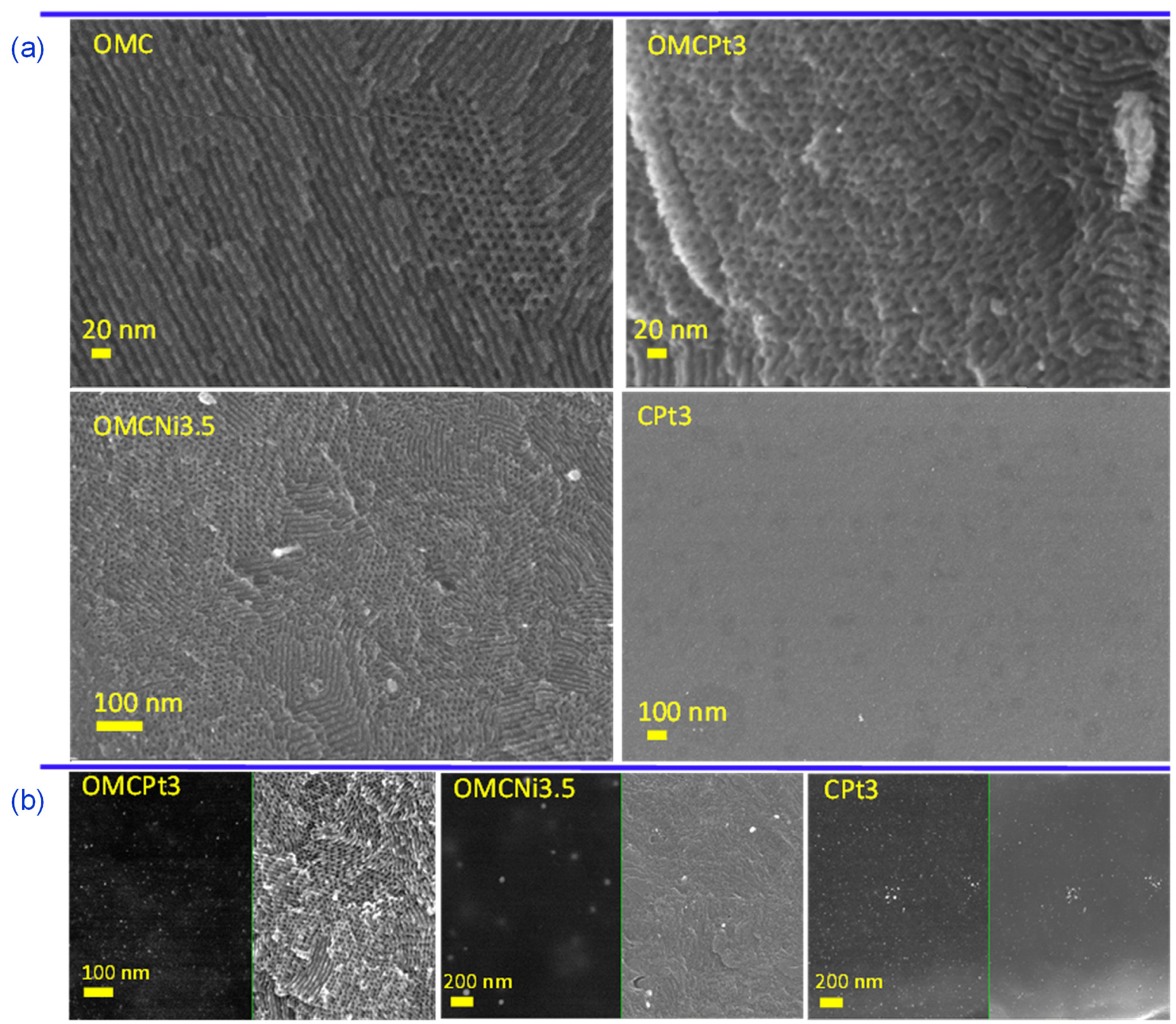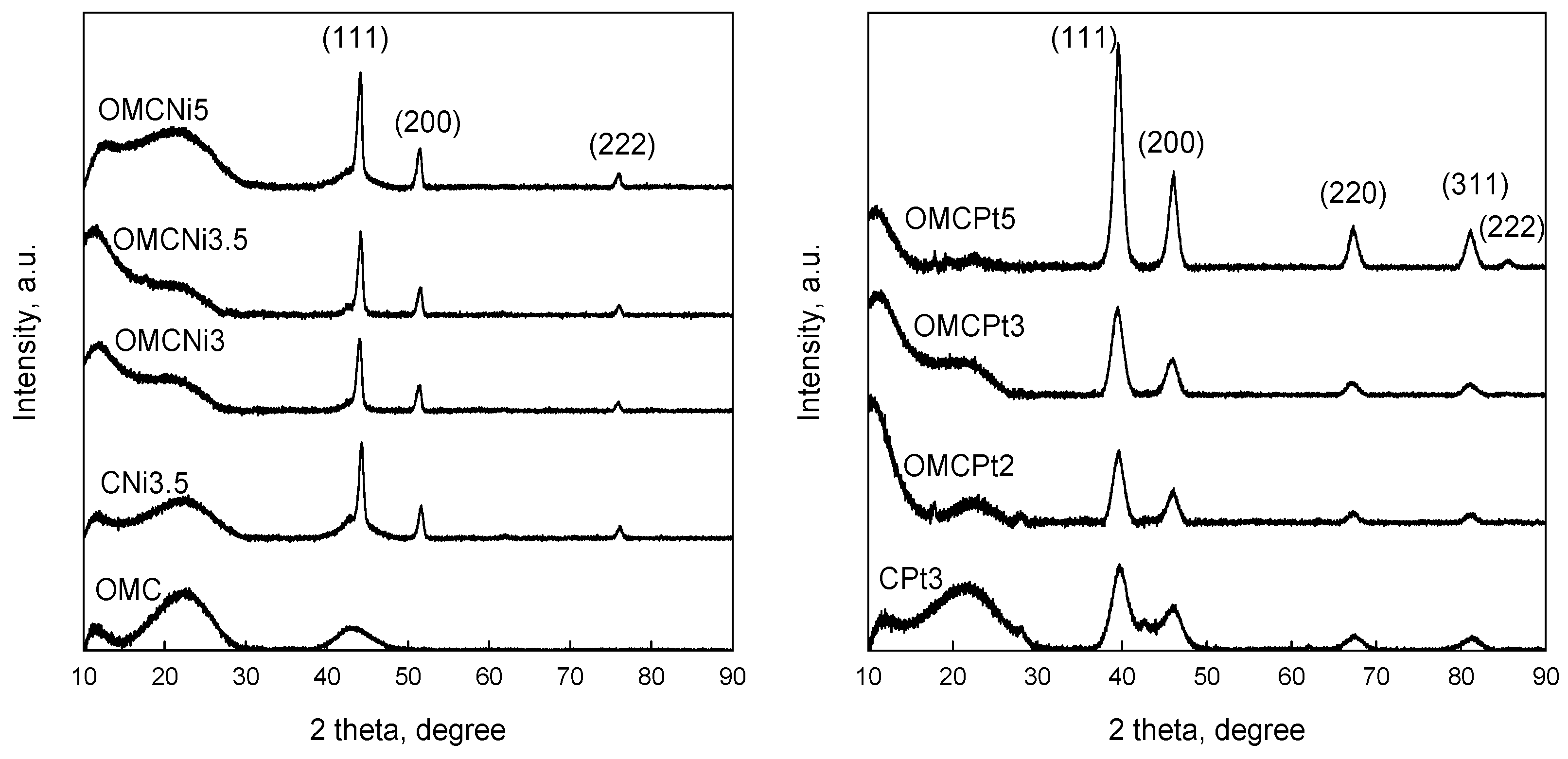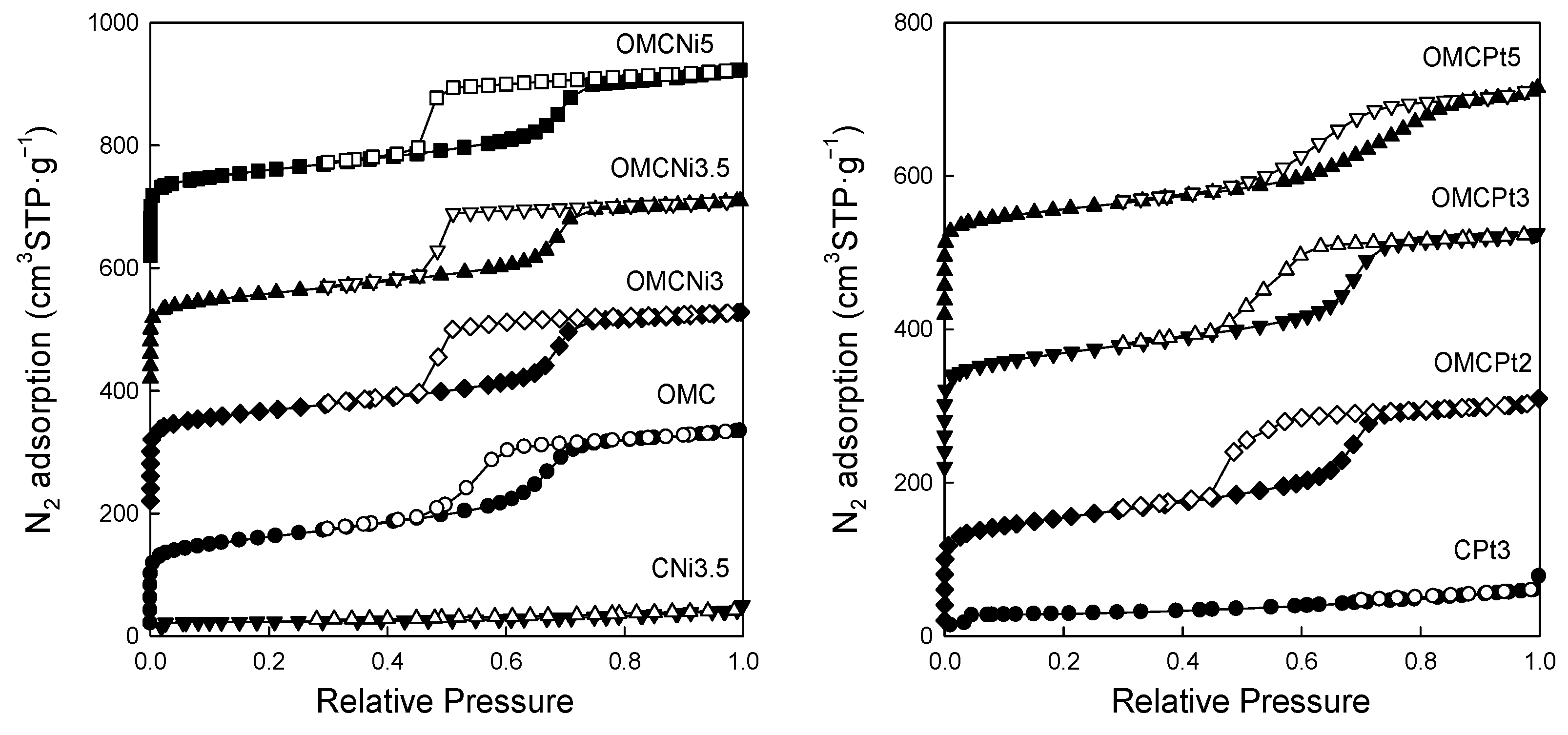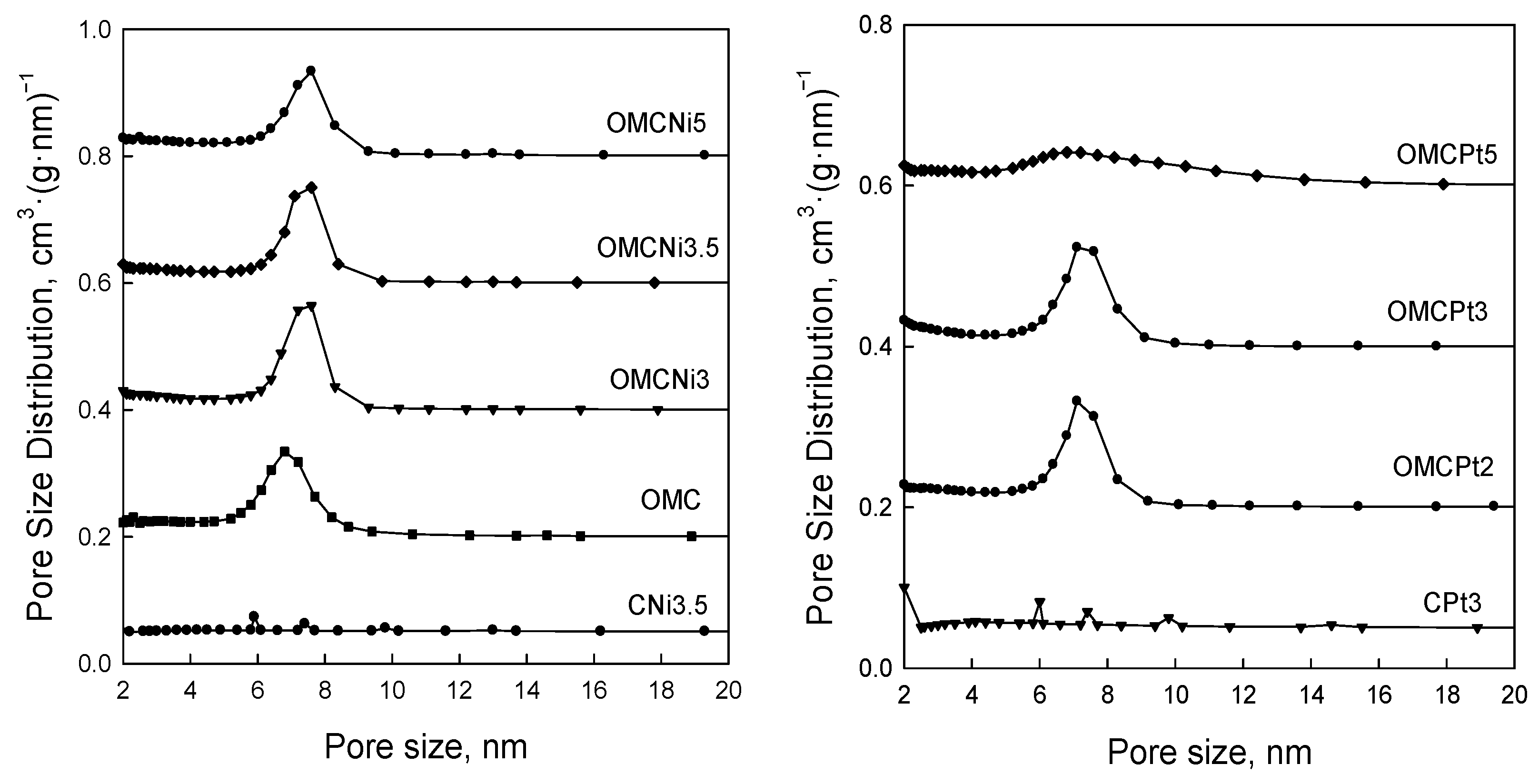Ordered Mesoporous Carbons with Well-Dispersed Nickel or Platinum Nanoparticles for Room Temperature Hydrogen Adsorption
Abstract
:1. Introduction
2. Results and Discussion
2.1. Morphological and Structural Characterization
2.2. Hydrogen Adsorption

3. Materials and Methods
3.1. Chemicals
3.2. Mechanochemical Synthesis of Metal-Decorated Ordered Mesoporous Carbons
3.3. Measurements and Calculations
4. Conclusions
Author Contributions
Funding
Institutional Review Board Statement
Informed Consent Statement
Data Availability Statement
Acknowledgments
Conflicts of Interest
Sample Availability
References
- Xiao, P.-W.; Zhao, L.; Sui, Z.-Y.; Xu, M.-Y.; Han, B.-H. Direct Synthesis of Ordered Mesoporous Hydrothermal Carbon Materials via a Modified Soft-Templating Method. Microporous Mesoporous Mater. 2017, 253, 215–222. [Google Scholar] [CrossRef]
- Liu, J.; Xie, L.; Wang, Z.; Mao, S.; Gong, Y.; Wang, Y. Biomass-Derived Ordered Mesoporous Carbon Nano-Ellipsoid Encapsulated Metal Nanoparticles inside: Ideal Nanoreactors for Shape-Selective Catalysis. Chem. Commun. 2020, 56, 229–232. [Google Scholar] [CrossRef]
- Schlienger, S.; Graff, A.-L.; Celzard, A.; Parmentier, J. Direct Synthesis of Ordered Mesoporous Polymer and Carbon Materials by a Biosourced Precursor. Green Chem. 2012, 14, 313–316. [Google Scholar] [CrossRef]
- Phuriragpitikhon, J.; Ghimire, P.; Jaroniec, M. Tannin-Derived Micro-Mesoporous Carbons Prepared by One-Step Activation with Potassium Oxalate and CO2. J. Colloid Interface Sci. 2020, 558, 55–67. [Google Scholar] [CrossRef] [PubMed]
- Nelson, K.M.; Mahurin, S.M.; Mayes, R.T.; Williamson, B.; Teague, C.M.; Binder, A.J.; Baggetto, L.; Veith, G.M.; Dai, S. Preparation and CO2 Adsorption Properties of Soft-Templated Mesoporous Carbons Derived from Chestnut Tannin Precursors. Microporous Mesoporous Mater. 2016, 222, 94–103. [Google Scholar] [CrossRef]
- Zhang, P.; Wang, L.; Yang, S.; Schott, J.A.; Liu, X.; Mahurin, S.M.; Huang, C.; Zhang, Y.; Fulvio, P.F.; Chisholm, M.F.; et al. Solid-State Synthesis of Ordered Mesoporous Carbon Catalysts via a Mechanochemical Assembly through Coordination Cross-Linking. Nat. Commun. 2017, 8, 15020. [Google Scholar] [CrossRef] [PubMed]
- Castro-Gutiérrez, J.; Sanchez-Sanchez, A.; Ghanbaja, J.; Díez, N.; Sevilla, M.; Celzard, A.; Fierro, V. Synthesis of Perfectly Ordered Mesoporous Carbons by Water-Assisted Mechanochemical Self-Assembly of Tannin. Green Chem. 2018, 20, 5123–5132. [Google Scholar] [CrossRef]
- Castro-Gutiérrez, J.; Díez, N.; Sevilla, M.; Izquierdo, M.T.; Ghanbaja, J.; Celzard, A.; Fierro, V. High-Rate Capability of Supercapacitors Based on Tannin-Derived Ordered Mesoporous Carbons. ACS Sustain. Chem. Eng. 2019, 7, 17627–17635. [Google Scholar] [CrossRef]
- Braghiroli, F.L.; Fierro, V.; Parmentier, J.; Pasc, A.; Celzard, A. Easy and Eco-Friendly Synthesis of Ordered Mesoporous Carbons by Self-Assembly of Tannin with a Block Copolymer. Green Chem. 2016, 18, 3265–3271. [Google Scholar] [CrossRef]
- Shan, W.; Zhang, P.; Yang, S.; Zhu, H.; Wu, P.; Xing, H.; Dai, S. Sustainable Synthesis of Alkaline Metal Oxide-Mesoporous Carbons via Mechanochemical Coordination Self-Assembly. J. Mater. Chem. A 2017, 5, 23446–23452. [Google Scholar] [CrossRef]
- Wang, L.; Zhao, J.; Zhang, P.; Yang, S.; Zhan, W.; Dai, S. Mechanochemical Synthesis of Ruthenium Cluster@Ordered Mesoporous Carbon Catalysts by Synergetic Dual Templates. Chem.-A Eur. J. 2019, 25, 8494–8498. [Google Scholar] [CrossRef]
- Zhang, P.; Chen, N.; Chen, D.; Yang, S.; Liu, X.; Wang, L.; Wu, P.; Phillip, N.; Yang, G.; Dai, S. Ultra-Stable and High-Cobalt-Loaded Cobalt@Ordered Mesoporous Carbon Catalysts: All-in-One Deoxygenation of Ketone into Alkylbenzene. ChemCatChem 2018, 10, 3299–3304. [Google Scholar] [CrossRef]
- Szczesniak, B.; Borysiuk, S.; Choma, J.; Jaroniec, M. Mechanochemical Synthesis of Highly Porous Materials. Mater. Horizons 2020, 7, 1457–1473. [Google Scholar] [CrossRef]
- Sevilla, M.; Mokaya, R. Energy Storage Applications of Activated Carbons: Supercapacitors and Hydrogen Storage. Energy Environ. Sci. 2014, 7, 1250–1280. [Google Scholar] [CrossRef]
- Hren, R.; Vujanović, A.; Van Fan, Y.; Klemeš, J.J.; Krajnc, D.; Čuček, L. Hydrogen Production, Storage and Transport for Renewable Energy and Chemicals: An Environmental Footprint Assessment. Renew. Sustain. Energy Rev. 2023, 173, 113113. [Google Scholar] [CrossRef]
- Castro-Muñiz, A.; Suárez-García, F.; Martínez-Alonso, A.; Tascón, J.M.D.; Kyotani, T. Energy Storage on Ultrahigh Surface Area Activated Carbon Fibers Derived from PMIA. ChemSusChem 2013, 6, 1406–1413. [Google Scholar] [CrossRef] [PubMed]
- Bahn, E.; Czakkel, O.; Nagy, B.; László, K.; Villar-Rodil, S.; Tascón, J.M.D.; Demmel, F.; Telling, M.T.F.; Fouquet, P. Diffusion of Molecular Hydrogen in Carbon Aerogel. Carbon N. Y. 2016, 98, 572–581. [Google Scholar] [CrossRef]
- Shen, H.; Li, H.; Yang, Z.; Li, C. Magic of Hydrogen Spillover: Understanding and Application. Green Energy Environ. 2022, 7, 1161–1198. [Google Scholar] [CrossRef]
- Parambhath, V.B.; Nagar, R.; Sethupathi, K.; Ramaprabhu, S. Investigation of Spillover Mechanism in Palladium Decorated Hydrogen Exfoliated Functionalized Graphene. J. Phys. Chem. C 2011, 115, 15679–15685. [Google Scholar] [CrossRef]
- Thommes, M.; Kaneko, K.; Neimark, A.; Olivier, J.; Rodriguez-Reinoso, F.; Rouquerol, J.; Sing, K. Physisorption of Gases, with Special Reference to the Evaluation of Surface Area and Pore Size Distribution (IUPAC Technical Report). Pure Appl. Chem. 2015, 87, 1051–1069. [Google Scholar] [CrossRef]
- Lozano-Castelló, D.; Cazorla-Amorós, D.; Linares-Solano, A. Usefulness of CO2 Adsorption at 273 K for the Characterization of Porous Carbons. Carbon N. Y. 2004, 42, 1233–1242. [Google Scholar] [CrossRef]
- Takagi, H.; Hatori, H.; Yamada, Y. Reversible Adsorption/Desorption Property of Hydrogen on Carbon Surface. Carbon N. Y. 2005, 43, 3037–3039. [Google Scholar] [CrossRef]
- Saha, D.; Deng, S. Hydrogen Adsorption on Ordered Mesoporous Carbons Doped with Pd, Pt, Ni, and Ru. Langmuir 2009, 25, 12550–12560. [Google Scholar] [CrossRef]
- Huang, C.-C.; Li, Y.-H.; Wang, Y.-W.; Chen, C.-H. Hydrogen Storage in Cobalt-Embedded Ordered Mesoporous Carbon. Int. J. Hydrog. Energy 2013, 38, 3994–4002. [Google Scholar] [CrossRef]
- Giraudet, S.; Zhu, Z.; Yao, X.; Lu, G. Ordered Mesoporous Carbons Enriched with Nitrogen: Application to Hydrogen Storage. J. Phys. Chem. C 2010, 114, 8639–8645. [Google Scholar] [CrossRef]
- Akasaka, H.; Takahata, T.; Toda, I.; Ono, H.; Ohshio, S.; Himeno, S.; Kokubu, T.; Saitoh, H. Hydrogen Storage Ability of Porous Carbon Material Fabricated from Coffee Bean Wastes. Int. J. Hydrog. Energy 2011, 36, 580–585. [Google Scholar] [CrossRef]
- Li, J.; Jin, C.; Qian, R.; Wu, C.; Wang, Y.; Yan, Y.; Chen, Y. Hydrogen Absorption-Desorption Cycle Decay Mechanism of Palladium Nanoparticle Decorated Nitrogen Doped Graphene. Prog. Nat. Sci. Mater. Int. 2021, 31, 514–520. [Google Scholar] [CrossRef]
- Giraudet, S.; Zhu, Z. Hydrogen Adsorption in Nitrogen Enriched Ordered Mesoporous Carbons Doped with Nickel Nanoparticles. Carbon N. Y. 2011, 49, 398–405. [Google Scholar] [CrossRef]
- Szczęśniak, B.; Phuriragpitikhon, J.; Choma, J.; Jaroniec, M. Mechanochemical Synthesis of Three-Component Graphene Oxide/Ordered Mesoporous Carbon/Metal-Organic Framework Composites. J. Colloid Interface Sci. 2020, 577, 163–172. [Google Scholar] [CrossRef]
- Ke, F.; Yi, J.; Zhang, S.; Zhou, S.; Ravikovitch, P.I.; Kruk, M. Structures and Dimensions of Micelle-Templated Nanoporous Silicas Derived from Swollen Spherical Micelles of Temperature-Dependent Size. J. Colloid Interface Sci. 2019, 544, 312–320. [Google Scholar] [CrossRef]
- Brunauer, S.; Emmett, P.H.; Teller, E. Adsorption of Gases in Multimolecular Layers. J. Am. Chem. Soc. 1938, 60, 309–319. [Google Scholar] [CrossRef]
- Barrett, E.P.; Joyner, L.G.; Halenda, P.P. The Determination of Pore Volume and Area Distributions in Porous Substances. I. Computations from Nitrogen Isotherms. J. Am. Chem. Soc. 1951, 73, 373–380. [Google Scholar] [CrossRef]







| Sorbent | SBET m2·g−1 | Vt cm3·g−1 | Vmicro cm3·g−1 | Vmeso cm3·g−1 | w nm | Mesoporosity % | H2 Adsorption ·10−3 wt.% |
|---|---|---|---|---|---|---|---|
| OMC | 571 | 0.52 | 0.15 | 0.37 | 6.8 | 71 | 7.4 |
| OMCNi3 | 595 | 0.51 | 0.17 | 0.34 | 7.6 | 67 | 8.6 |
| OMCNi3.5 | 553 | 0.48 | 0.15 | 0.33 | 7.6 | 69 | 10.2 |
| OMCNi5 | 566 | 0.50 | 0.16 | 0.34 | 7.6 | 68 | 5.4 |
| OMCPt2 | 550 | 0.48 | 0.16 | 0.32 | 7.1 | 67 | 10.8 |
| OMCPt3 | 600 (1060 *) | 0.50 | 0.17 (0.19 *) | 0.30 | 7.1 | 64 | 12.0 |
| OMCPt5 | 558 | 0.49 | 0.18 | 0.31 | 6.8 | 63 | 10.0 |
| CNi3.5 | 80 | 0.08 | 0.04 | 0.04 | - | 50 | 7.8 |
| CPt3 | 100 (837 *) | 0.12 | 0.03 (0.21 *) | 0.09 | - | 75 | 14.6 |
| Sample | Hydrogen Adsorption, wt.% | Measurement Conditions (Temperature °C/Pressure Bar) | Ref. |
|---|---|---|---|
| OMC | 0.20 | 25/55 | [24] |
| CMK-3 | 0.24 | 25/45 | [25] |
| Carbon nitride | 0.05 | 25/45 | [25] |
| Activated carbon | 0.60 | 25/120 | [26] |
| Pd-decorated N-doped reduced graphene oxide | 0.46 | 25/10 | [27] |
| Co-embedded OMC | 0.45 | 25/55 | [24] |
| Ni-CMK-3 | 0.20 | 25/30 | [28] |
| Ni-decorated OMC | 0.75 * | 25/100 | [23] |
| Pt-decorated OMC | 0.50 * | 25/100 | [23] |
| Pd-decorated OMC | 0.40 * | 25/100 | [23] |
| Pt-decorated carbon | 0.32 | 25/100 | This work |
| Pt-decorated OMC | 0.33 | 25/100 | This work |
| Ni-decorated OMC | 0.30 | 25/100 | This work |
Disclaimer/Publisher’s Note: The statements, opinions and data contained in all publications are solely those of the individual author(s) and contributor(s) and not of MDPI and/or the editor(s). MDPI and/or the editor(s) disclaim responsibility for any injury to people or property resulting from any ideas, methods, instructions or products referred to in the content. |
© 2023 by the authors. Licensee MDPI, Basel, Switzerland. This article is an open access article distributed under the terms and conditions of the Creative Commons Attribution (CC BY) license (https://creativecommons.org/licenses/by/4.0/).
Share and Cite
Szczęśniak, B.; Głowniak, S.; Woźniak, J.; Popiel, S.; Choma, J.; Jaroniec, M. Ordered Mesoporous Carbons with Well-Dispersed Nickel or Platinum Nanoparticles for Room Temperature Hydrogen Adsorption. Molecules 2023, 28, 6551. https://doi.org/10.3390/molecules28186551
Szczęśniak B, Głowniak S, Woźniak J, Popiel S, Choma J, Jaroniec M. Ordered Mesoporous Carbons with Well-Dispersed Nickel or Platinum Nanoparticles for Room Temperature Hydrogen Adsorption. Molecules. 2023; 28(18):6551. https://doi.org/10.3390/molecules28186551
Chicago/Turabian StyleSzczęśniak, Barbara, Sylwia Głowniak, Jakub Woźniak, Stanisław Popiel, Jerzy Choma, and Mietek Jaroniec. 2023. "Ordered Mesoporous Carbons with Well-Dispersed Nickel or Platinum Nanoparticles for Room Temperature Hydrogen Adsorption" Molecules 28, no. 18: 6551. https://doi.org/10.3390/molecules28186551
APA StyleSzczęśniak, B., Głowniak, S., Woźniak, J., Popiel, S., Choma, J., & Jaroniec, M. (2023). Ordered Mesoporous Carbons with Well-Dispersed Nickel or Platinum Nanoparticles for Room Temperature Hydrogen Adsorption. Molecules, 28(18), 6551. https://doi.org/10.3390/molecules28186551









